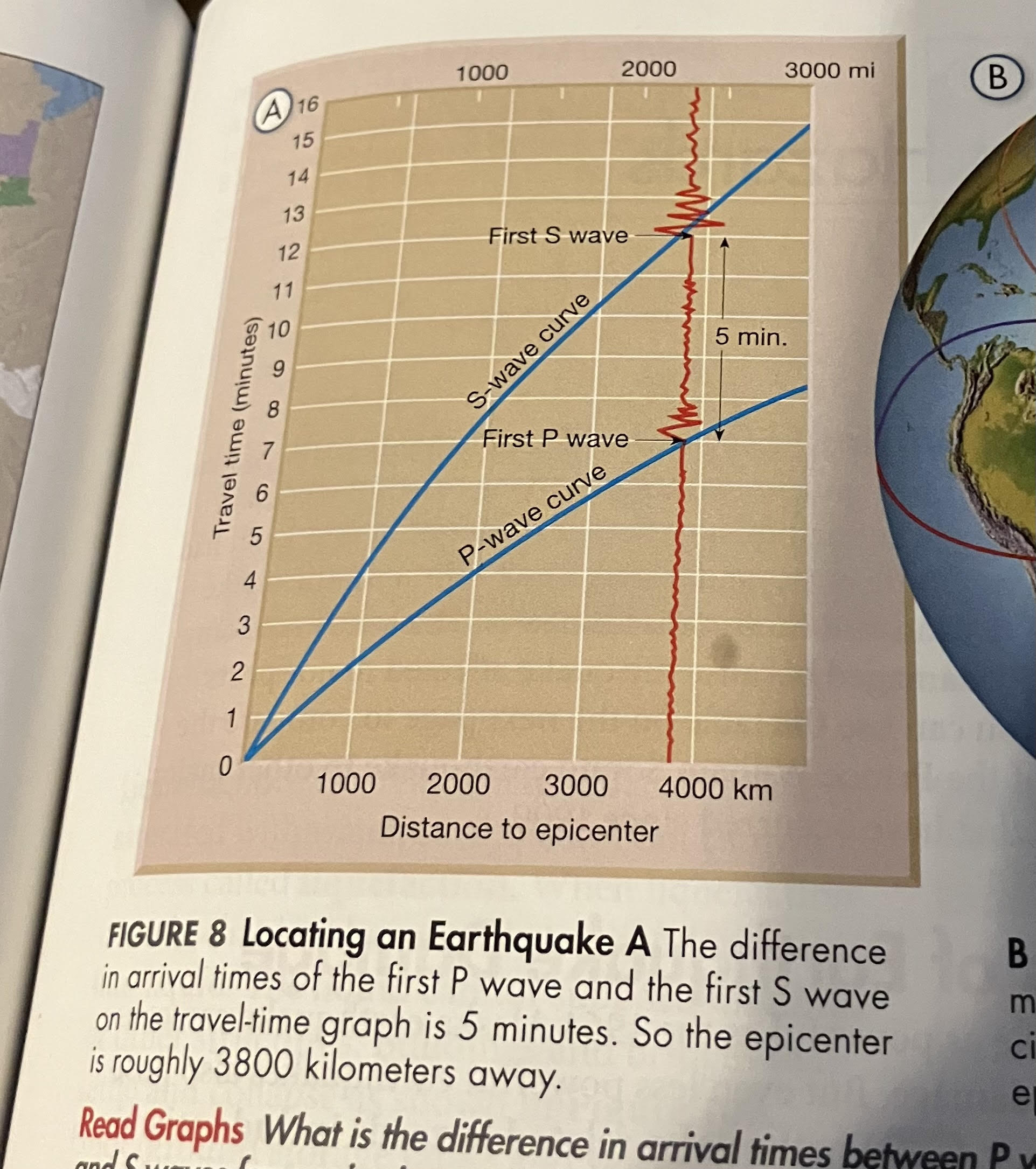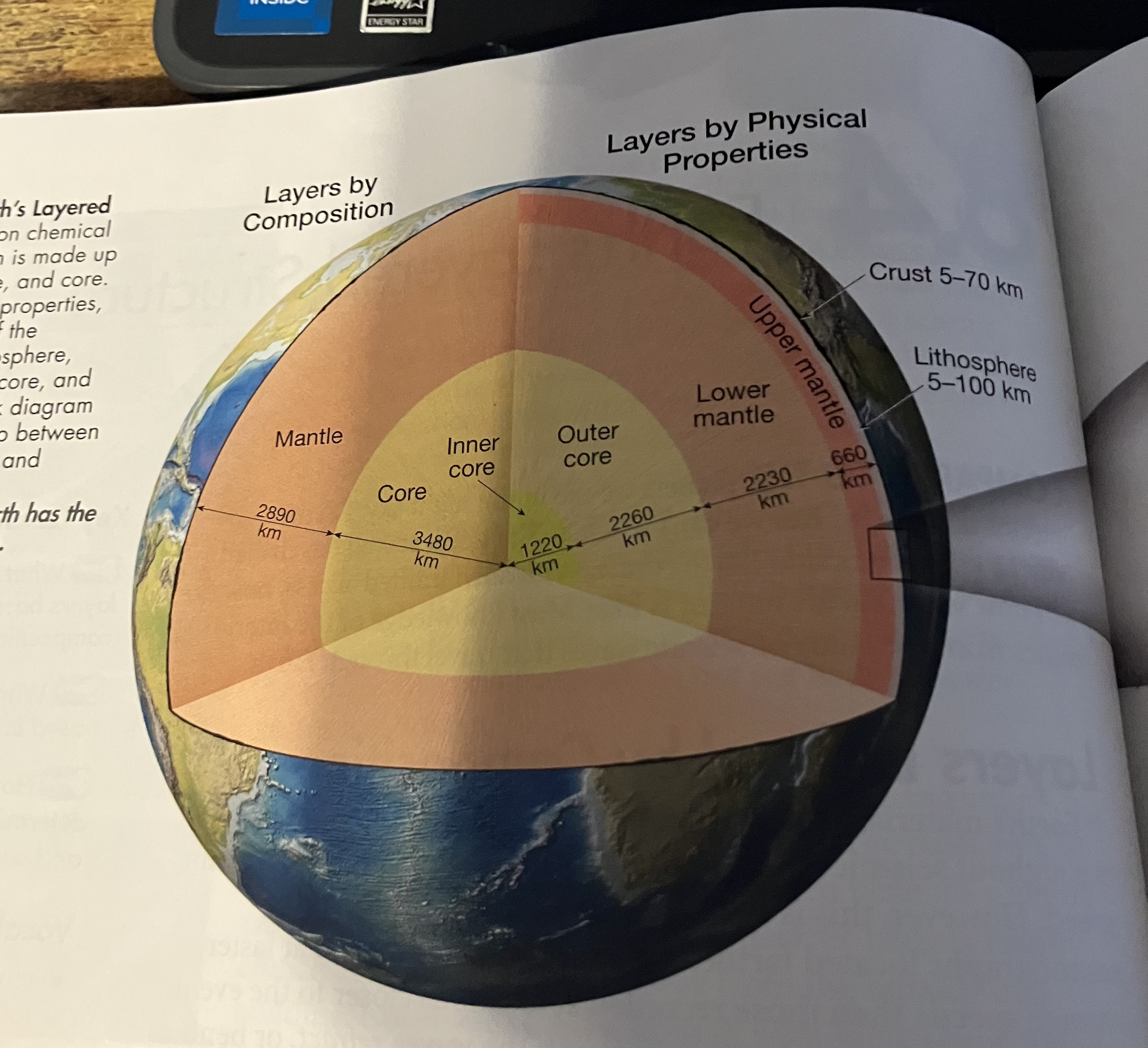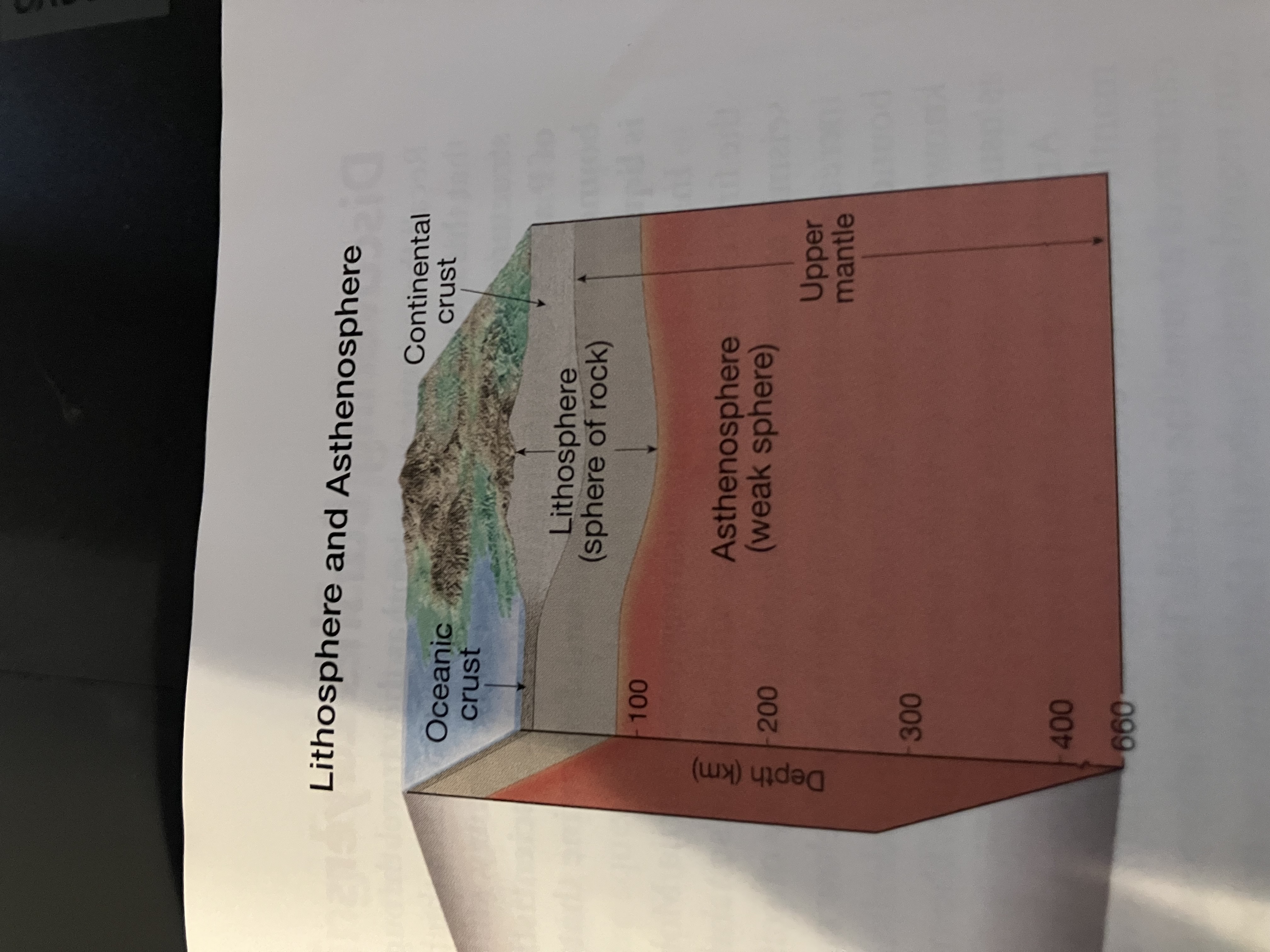Chapter 8: Earthquakes and Earth's Interior
1/33
Earn XP
Description and Tags
Academic Earth/Space Science
Name | Mastery | Learn | Test | Matching | Spaced |
|---|
No study sessions yet.
34 Terms
Fault defined.
Earthquakes are caused by slippage along a break in the lithosphere, called a fault. Faults are fractures in Earth where movement has occurred.
Epicenter defined.
When you see a news report about an earthquake, the reporter always mentions the place on Earth’s surface where the earthquake was centered. The epicenter is the location on the surface directly above the focus.
Focus defined.
The point within Earth where an earthquake starts is called the focus. The focus of an earthquake is located along a fault beneath the surface.
Earthquake defined.
An earthquake is the vibration of Earth produced by the rapid release of energy within the lithosphere.
Elastic rebound defined.
The tendency for the deformed rock along a fault to spring back after an earthquake is called elastic rebound.
Elastic rebound defined.
According to the elastic rebound hypothesis, most earthquakes are produced by the rapid release of energy stored in the rock that has been subjected to great forces. When the strength of the rock is exceeded, it suddenly breaks, releasing some of its stored energy as seismic waves.
Know the importance of elastic energy in relation to earthquakes.
Forces inside Earth slowly deform the rock that makes up Earth’s crust, causing the rock to change it’s shape or bend. As rocks bend, they store elastic energy, just as a wooden stick does when it is bent. Elastic energy is the energy associated with objects that can be stretched or compressed. Elastic energy is stored when you stretch a rubber band or compress a spring.
Foreshocks defined.
Small earthquakes called foreshocks sometimes come before a major earthquake. Foreshocks can happen days or even years before the major quake.
Aftershocks defined.
An aftershock is an earthquake that occurs sometime soon after a major earthquake. Aftershocks may occur hours or even weeks after the major earthquake. Although usually much weaker than the main earthquake, an aftershock can still damage structures already weakened by the main quake.
Fault creep defined.
Some parts of the fault show a slow, gradual movement known as fault creep.
General question about the 1906 earthquake of San Fransisco.
Before the great San Fransisco earthquake, scientists did not understand what causes earthquakes. Measurements and studies after the 1906 earthquake led to the development of a hypothesis that explains how earthquakes occur.
General question regarding foreshocks.
Even a strong earthquake, such as the 1906 San Francisco earthquake, usually does not release all the elastic energy stored in the rock along a fault. Aftershocks and foreshocks also release some of a fault’s stored elastic energy.
All about P waves, S waves, and surface waves.
Earthquakes produced two main types of seismic waves — body waves and surface waves. These seismic waves different in their type of wave motion, their behavior as they travel through Earth, and their speed. Body waves travel through Earth’s interior to the surface. Surface waves only travel at the surface. There are two types of body waves: P waves and S waves.
All about P waves, S waves, and surface waves.
P waves compress, or push, and expand, or pull particles in the direction the waves travel. P waves are also known as compressional waves. The motion of P waves can be illustrated by attaching one end of a spring toy to a wall and pushing and pulling on the other end, as shown in Figure 4A. P waves cause material to compress and then spring back once the force is removed. Since solids, liquids, and gases all have the ability to alternatively compress and expand in response to a force, P waves can travel through all three states of matter. The back-and-forth motion of P waves causes the ground to buckle and fracture as shown in Figure 4B.

All about P waves, S waves, and surface waves.
S waves shake particles at right angles to the direction that the waves travel. S-waves are also called transverse waves. Their motion can be illustrated by attaching one end of a rope to a wall and shaking the other end up-and-down, as shown in Figure 4C. S waves temporarily change the shape of the material that transmits them. Since liquids and gases will not return to their shape once a force is removed, they will not transmit S waves. Solids, on the other hand, do resist changes in their shape, so they will transmit S waves. As Figure 4D shows, S waves cause the ground to shake sideways and up-and-down. S waves travel more slowly than P waves.

All about P waves, S waves, and surface waves.
When body waves reach the surface, they produce surface waves. Surface waves travel more slowly than body waves. As shown in Figure 4E and 4F, surface waves can move the ground up-and-down as well as side to side. Surface waves are usually much larger than body waves. As a result, surface waves are the most.

Know how triangulation is used to find an earthquake’s epicenter.
It’s used to pin-point the epicenter of an earthquake.
Know the purpose of a time-travel graph.
You use the travel-time graph to determine the distance from each seismic station to the epicenter.
Be able to read a time-travel graph.

Earthquake magnitude defined.
Magnitude is is a measure of the size of seismic waves or the amount of energy released at the source of the earthquake.
Know which scale for measuring earthquakes is most widely used today.
Scientists today use a more precise means of measuring earthquakes. It is called the moment magnitude scale. The moment magnitude is derived from the amount of displacement that occurs along a fault. Moment magnitude is the most widely used measurement for earthquakes because it is the only magnitude scale that estimates the energy released by earthquakes.
Seismograph v.s. seismogram.
An instrument that records seismic waves is called a seismograph. It provides a reference point for measuring the amount of ground movement of Earth relative to the stationary weight on a rotating drum. A seismograph produces a time record of ground motion during an earthquake called a seismogram. A seismogram shows all three types of seismic waves. The stronger the earthquake, the larger the waves on the seismogram.
Intensity v.s. magnitude.
Intensity is a measure of the amount of earthquake shaking at a given location based on the amount of damage. Magnitude is a measure of the size of seismic waves or the amount of energy released at the source of the earthquake.
Know how the Richter scale measures earthquakes.
The Richter scale and the moment magnitude scale measure earthquake magnitude. The Modified Mercalli scale is based on earthquake intensity.
Know how the Richter scale measures earthquakes.
A familiar but outdated scale for measuring the magnitude of earthquakes is the Richter scale. The Richter scale is based on the height of the largest seismic wave (P, S, or surface wave) recorded on a seismogram.
Know what factors contribute to an earthquake’s destruction.
Earthquake damage and loss of life can be reduced by determine the earthquake risk for an area, building earthquake-resistant structures, and following earthquake safety precautions.
Tsunami defined.
A tsunami is a series of waves formed when the ocean floor shifts suddenly during an earthquake. An underwater landslide or volcanic eruption can also trigger a tsunami. For example in 2004 a magnitude- 9.3 earthquake west of the island of Sumatra in the India Ocean produced devastating tsunamis.
Liquefaction defined.
In areas where soil and rock are saturated with water, earthquakes can cause a process called liquefaction. When liquefaction occurs, what had been stable soil suddenly turns into liquid. The liquid cannot support buildings or other structures. Buildings and bridges may settle and collapse.
Examples of liquefaction.
During the 1989 Loma Prieta earthquake in San Francisco’s Marina District, foundations failed and geysers of sand and water shot from the ground, indicating that liquefaction had occurred.
Know various hazards associated with earthquakes.
Earthquake-related hazards include seismic shaking, liquefaction, landslides and mudflows, and tsunamis.
Lithosphere defined.
Earth’s outermost layer consists of the crust and uppermost mantle and forms a relatively cool, rigid shell called the lithosphere.
Know everything about the layers of the Earth.
Earth’s interior consists of three major layers defined by their chemical composition — the crust, mantle, and core.
The crust — the thin, rocky outer layer of Earth — is divided into oceanic and continental crust.
Over 82 percent of Earth’s volume is contained in the mantle — a solid rocky shell that extends to a depth of 2890 kilometers. The boundary between the crust and mantle represents a change in chemical composition. A common rock type in the uppermost mantle is peridotite.
The core is a sphere composed mostly of an iron-nickel alloy. At the extreme pressures found in the center if the core, the average density of iron-rich material is 13 grams.

Know everything about the layers of the Earth.
Earth can be divided into layers based on physical properties — the lithosphere, the asthenosphere, lower mantle, the outer core, and inner core.
Earth’s outermost layer consists of the crust and uppermost mantle and forms a relatively cool, rigid shell called the lithosphere.
Beneath the lithosphere lies a soft, comparatively weak layer known as the asthenosphere. Within the asthenosphere, the rocks are close enough to their melting temperatures that they are easily deformed. Thus, the asthenosphere is weak because it is near it’s melting point, just as hot wax is weaker than cold wax. The lower lithosphere and asthenosphere are both part of the upper mantle.
From depth of about kilometers down to near the base of the mantle lies a more rigid layer called the lower mantle. Despite their strength, the rocks of the lower mantle are still very hot and capable of gradual flow.
The core, which is composed mostly of an iron-nickel alloy, is divided into two regions with different physical properties. The outer core is a liquid layer. The flow of metallic iron within this layer generates Earth’s magnetic field. The inner core is a sphere. Despite it’s higher temperatures, the materials in the inner core are compressed into a solid state by the immense pressure.

Moho defined.
In 1909, Croatian seismologist, Andrija Mohorovicic, presented the first evidence of layering within Earth’s mantle. By studying seismic records, he found that the velocity of seismic waves increased abruptly about 50 kilometers below eastern Europe. This boundary separates the crust from the underlying mantle and is now known as the Mohorovicic discontinuity. The name of the boundary is usually shortened to Moho.